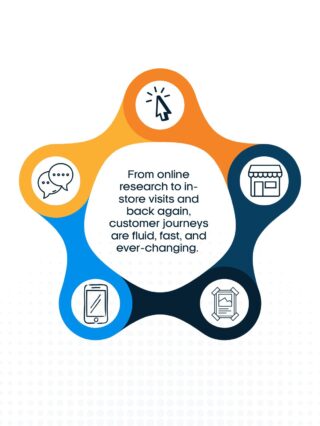Last week, members of our Programmatic team attended the Digiday Programmatic Summit in Palm Springs where industry leaders explored the current digital advertising landscape. At the forefront of discussions were key themes such as identity, supply, privacy, and the transformative role of AI. Keep reading to see our major takeaways from the conference, shedding light on how these factors are reshaping the digital advertising ecosystem and offering strategies to navigate these changes.
Identity, Supply, Privacy, and AI
We heard from panelists that the digital advertising industry is undergoing significant changes due to the phase-out of cookies, with AI playing a crucial role in enhancing targeting and measurement through deterministic identifiers. Simultaneously, tightening privacy regulations and the need for sustainability are becoming major focuses, as companies strive to comply with data practices and reduce carbon emissions. Moreover, addressing the challenge of Made-for-Advertising (MFA) sites and adopting a hybrid approach combining universal IDs with first-party data are essential strategies for the future of digital advertising.
Navigating the Future of Digital Advertising: Challenges, Opportunities, and Strategic Adaptations
The deprecation of third-party cookies, announced by Google in 2020, marks a pivotal shift within our industry. Panelists discussed that as we move towards a cookie-less future, the digital advertising landscape is undergoing significant transformations. While browsers like Firefox and Safari have already implemented stringent cookie policies, Google’s Privacy Sandbox is still in its experimental phase. This delay is partly due to the ingrained industry culture, where advertisers are accustomed to traditional methods of performance measurement and media allocation.
Google’s New Privacy Sandbox: Embracing a New Paradigm
The Privacy Sandbox introduces a suite of APIs designed to help advertisers adapt to a cookie-less world:
- Topics API: Facilitates contextual targeting by categorizing user interests based on browsing history.
- Protected Audience API: Enables retargeting without cookies.
- Attribution Reporting API: Manages conversion reporting in a privacy-compliant manner.
These tools require marketers to rethink their data strategies. Data clean rooms and synthetic data modeling are emerging technologies. Data clean rooms allow for secure data analysis without compromising privacy, while synthetic data modeling uses real customer data to create enhanced data sets, maintaining privacy while providing actionable insights.
Balancing Act: Universal IDs and First-Party Data
A hybrid approach combining Demand-Side Platform (DSP) universal IDs with first-party data is gaining traction in the programmatic space. This strategy, supported by data clean rooms, leverages core truths from real customer data and integrates deterministic data like email addresses with probabilistic models. This combination ensures more accurate targeting and measurement while preserving user privacy.
Our Cookie-less Testing Strategy
At Butler/Till, we recognize the importance of futureproofing our clients’ campaigns. Our programmatic healthcare team leverages numerous third-party audience vendors, which build segments using various methodologies and transport these segments into a DSP. Our cookie-less testing strategy focuses on isolating activation to non-cookie-based IDs only, specifically Ramp IDs. The intention of this test is to ensure our clients can continue delivering high-performing campaigns as we transition to a post-cookie world. By executing this test now, we aim to assess the scale, cost, and performance of these identifiers ahead of time.
AI: Bridging the Addressability Gap
As cookies phase out, AI becomes essential in bridging the addressability gap. By integrating deterministic identifiers, AI enhances targeting and measurement, offering real-time optimization and predictive analytics.
Sustainability and Transparency in Programmatic Supply Chains
Sustainability is becoming a priority in the programmatic supply chain. Companies like Scope3 emphasize reducing carbon emissions, and AI plays a pivotal role in optimizing processes to lower environmental impact. Clean supply paths, minimizing intermediaries, and holding suppliers accountable for transparency are essential steps towards a more sustainable advertising ecosystem.
Addressing the Issue of Made-for-Advertising (MFA) Sites
MFA sites, designed primarily for ad revenue rather than user value, present a significant challenge. While not inherently fraudulent, their use is often driven by the low-cost reach they offer brands. However, the frequent ad slot refreshes and other tactics used by MFAs are problematic.
How we are addressing MFAs
At Butler/Till, we’ve taken a firm stance against MFAs, filtering them out as much as possible. Our strategy includes:
- Adopting MFA Block Lists: Rapid adoption of block lists from sources like Double Verify, DSPs, Moat/Grapeshot, IAS, and others.
- MFA Monitoring: Adding MFA monitoring and blocking to our standard campaign profile in Double Verify.
- Disciplined Media Buying: Focusing on performance over low-cost reach to filter out low-quality sites.
- Partnership with Jounce Media: Pursuing a partnership with Jounce Media to access their supply chain research tool, allowing for better self-curated block lists. This comes at a modest cost of $0.01 CPM, which we plan to include in brand safety budgets.
Embracing AI and Privacy for the Future
Panelists covered the future of programmatic advertising and emphasized it lies in embracing AI for deeper personalization, enhanced transparency, and more efficient operations. Agencies must engage in proactive testing and collaboration with clients to navigate this evolving landscape, ensuring privacy compliance and maximizing ad spend efficiency.
Key Strategies for Marketers
- Adapt to Privacy Changes: Utilize tools like Google’s Privacy Sandbox and data clean rooms to navigate a cookie-less world.
- Align with Consumer Values: Embrace sustainability and transparency to build stronger relationships with modern consumers.
- Optimize Supply Chains: Focus on clean and efficient supply paths to reduce fraud and improve ad performance.
- Leverage AI: Use AI to enhance personalization, optimize creative content, and streamline operations.
- Prioritize Sustainability: Work towards reducing the carbon footprint of programmatic advertising and adopt new industry standards.
By understanding these trends and implementing strategic changes, marketers can better navigate the complexities of the digital advertising landscape and drive meaningful results in a rapidly changing environment. We heard in-depth analysis on the transition to a cookie-less world and how it presents both challenges and opportunities. Leveraging AI, first-party data, and innovative targeting methods will enable the advertising industry to adapt and thrive in this new era of privacy-conscious digital marketing. If you have any questions on our takeaways from the Digiday conference, please contact our team of experts today!
Contributors: Adrian Newbill, Laura Smith




